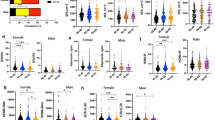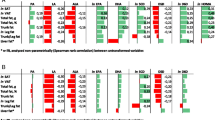Abstract
Purpose
Ageing is directly associated with visceral fat (VAT) deposition and decline of metabolically active cellular mass, which may determine age-related shifts in substrate oxidation and increased cardiometabolic risk. We tested whether VAT and fasting respiratory quotient (RQ, an index of macronutrient oxidation) changed with age and if they were associated with increased risk of metabolic syndrome (MetSyn).
Methods
A total of 2819 adult participants (age range: 18–81 years; men/women: 894/1925) were included; we collected history, anthropometric measures, biochemistry, smoking habits, and physical activity. The body mass index range was 18.5–60.2 kg/m2. Gas exchanges (VO2 and VCO2) were measured by indirect calorimetry in fasting conditions, and RQ was calculated. Body composition was measured by bioelectrical impedance. Abdominal subcutaneous fat and VAT were measured by ultrasonography. MetSyn was diagnosed using harmonised international criteria. Multivariate linear and logistic regression models were utilised.
Results
VAT increased with age in both men (r = 0.31, p < 0.001) and women (r = 0.37, p < 0.001). Basal RQ was not significantly associated with age (p = 0.49) and VAT (p = 0.20); in addition, basal RQ was not a significant predictor of MetSyn (OR 3.31, 0.57–19.08, p = 0.27). VAT was the primary predictor of MetSyn risk in a fully adjusted logistic model (OR 4.25, 3.01–5.99, p < 0.001).
Conclusions
Visceral adiposity remains one of the most important risk factors for cardiometabolic risk and is a significant predictor of MetSyn. Post-absorptive substrate oxidation does not appear to play a significant role in age-related changes in body composition and cardiometabolic risk, except for a correlation with triglyceride concentration.


Similar content being viewed by others
References
Roberts SB, Rosenberg I (2006) Nutrition and aging: changes in the regulation of energy metabolism with aging. Physiol Rev 86:651–667
Siervo M et al (2015) Age-related changes in resting energy expenditure in normal weight, overweight and obese men and women. Maturitas 80(4):406–413
St-Onge MP, Gallagher D (2010) Body composition changes with aging: the cause or the result of alterations in metabolic rate and macronutrient oxidation? Nutrition 26:152–155
Tchernof A, Després J-P (2013) Pathophysiology of human visceral obesity: an update. Physiol Rev 93:359–404
Schutz Y (1995) Abnormalities of fuel utilization as predisposing to the development of obesity in humans. Obes Res 3(Suppl 2):173s–178s
Astrup A (2011) The relevance of increased fat oxidation for body-weight management: metabolic inflexibility in the predisposition to weight gain. Obe Rev 12:859–865
Sial S et al (1996) Fat and carbohydrate metabolism during exercise in elderly and young subjects. Am J Physiol 271:E983–E989
Solomon TP et al (2008) Exercise and diet enhance fat oxidation and reduce insulin resistance in older obese adults. J Appl Physiol 104:1313–1319
Kuk JL et al (2009) Age-related changes in total and regional fat distribution. Ageing Res Rev 8:339–348
Konopka AR, Sreekumaran Nair K (2013) Mitochondrial and skeletal muscle health with advancing age. Mol Cell Endocrinol 379:19–29
Huffman DM, Barzilai N (2009) Role of visceral adipose tissue in aging. Biochim Biophys Acta 1790:1117–1123
Manini TM (2010) Energy expenditure and aging. Ageing Res Rev 9:1–11
Slawik M, Vidal-Puig AJ (2006) Lipotoxicity, overnutrition and energy metabolism in aging. Age Res Rev 5:144–164
Bergouignan A et al (2014) Twenty-four hour total and dietary fat oxidation in lean, obese and reduced-obese adults with and without a bout of exercise. PLoS One 9:e94181
Croci I et al (2013) Whole-body substrate metabolism is associated with disease severity in patients with non-alcoholic fatty liver disease. Gut 62:1625–1633
Ferro Y et al (2013) Fat utilization and arterial hypertension in overweight/obese subjects. J Transl Med 11:159
Galgani JE et al (2014) Relationship between whole-body macronutrient oxidative partitioning and pancreatic insulin secretion/beta-cell function in non-diabetic humans. Metab Clin Exp 63:1426–1431
Montalcini T et al (2013) Metabolic fuel utilization and subclinical atherosclerosis in overweight/obese subjects. Endocrine 44:380–385
Montalcini T et al (2014) Subclinical cardiovascular damage and fat utilization in overweight/obese individuals receiving the same dietary and pharmacological interventions. Nutrients 6:5560–5571
Montalcini T et al (2014) Nutrients utilization in obese individuals with and without hypertriglyceridemia. Nutrients 6:790–798
Solomon TP et al (2008) Effects of aging on basal fat oxidation in obese humans. Metab Clin Exp 57:1141–1147
Levadoux E et al (2001) Reduced whole-body fat oxidation in women and in the elderly. Int J Obes Relat Metab Disord 25:39–44
Nagy TR et al (1996) Determinants of basal fat oxidation in healthy Caucasians. J Appl Physiol 80:1743–1748
Toth MJ et al (1999) Hormonal and physiological correlates of energy expenditure and substrate oxidation in middle-aged, premenopausal women. J Clin Endocrinol Metab 84:2771–2775
Craig CL et al (2003) International Physical Activity Questionnaire: 12-country reliability and validity. Med Sci Sports Exerc 35:1381–1395
Armellini F et al (1990) The contribution of sonography to the measurement of intra-abdominal fat. J Clin Ultrasound 18:563–567
Isbell TR et al (1991) Measurement reliability and reactivity using repeated measurements of resting energy expenditure with a face mask, mouthpiece, and ventilated canopy. JPEN J Parenter Enteral Nutr 15:165–168
Weir JBdV (1949) New methods for calculating metabolic rate with special reference to protein metabolism. J Physiol 109:1–9
Lusk G (1924) Animal calorimetry. Analysis of the oxidation of mixtures of carbohydrate and fat. J Biol Chem 59:41–42
Schutz Y et al (1992) Role of fat oxidation in the long-term stabilization of body weight in obese women. Am J Clin Nutr 55:670–674
Chobanian AV et al (2003) Seventh report of the Joint National Committee on prevention, detection, evaluation, and treatment of high blood pressure. Hypertension 42:1206–1252
Alberti KGMM et al (2009) Harmonizing the Metabolic Syndrome: a Joint Interim Statement of the International Diabetes Federation Task Force on Epidemiology and Prevention; National Heart, Lung, and Blood Institute; American Heart Association; World Heart Federation; International Atherosclerosis Society; and International Association for the Study of Obesity. Circulation 120:1640–1645
Siervo M et al (2010) First-borns carry a higher metabolic risk in early adulthood: evidence from a prospective cohort study. PLoS One 5:e13907
Klein S et al (2007) Waist circumference and cardiometabolic risk: a consensus statement from Shaping America’s Health: association for Weight Management and Obesity Prevention; NAASO, The Obesity Society; the American Society for Nutrition; and the American Diabetes Association. Am J Clin Nutr 85:1197–1202
Astrup A et al (1994) Obesity as an adaptation to a high-fat diet: evidence from a cross-sectional study. Am J Clin Nutr 59:350–355
Calles-Escandon J et al (1995) Basal fat oxidation decreases with aging in women. J Appl Physiol 78:266–271
Seidell JC et al (1992) Fasting respiratory exchange ratio and resting metabolic rate as predictors of weight gain: the Baltimore Longitudinal Study on Aging. Int J Obes Relat Metab Disord 16:667–674
Toth MJ et al (1998) Gender differences in fat oxidation and sympathetic nervous system activity at rest and during submaximal exercise in older individuals. Clin Sci 95:59–66
Valtuena S et al (1997) The respiratory quotient as a prognostic factor in weight-loss rebound. Int J Obes Relat Metab Disord 21:811–817
Weyer C et al (1999) Determinants of energy expenditure and fuel utilization in man: effects of body composition, age, sex, ethnicity and glucose tolerance in 916 subjects. Int J Obes Relat Metab Disord 23:715–722
Zurlo F et al (1990) Low ratio of fat to carbohydrate oxidation as predictor of weight gain: study of 24-h RQ. Am J Physiol 259:E650–E657
Soares MJ et al (2000) Plasma leptin concentrations, basal metabolic rates and respiratory quotients in young and older adults. Int J Obes Relat Metab Disord 24:1592–1599
López-Otín C et al (2013) The hallmarks of aging. Cell 153:1194–1217
Navaratnarajah A, Jackson SHD (2013) The physiology of ageing. Medicine 41:5–8
Raben A et al (1994) Evidence for an abnormal postprandial response to a high-fat meal in women predisposed to obesity. Am J Physiol 267:E549–E559
North BJ, Sinclair DA (2012) The intersection between aging and cardiovascular disease. Circ Res 110:1097–1108
Pontiroli AE et al (2002) Ultrasound measurement of visceral and subcutaneous fat in morbidly obese patients before and after laparoscopic adjustable gastric banding: comparison with computerized tomography and with anthropometric measurements. Obes Surg 12:648–651
Statement of authorship
The manuscript was conceived by MS who analysed the data and wrote the first draft of the manuscript. Data were collected by AL, SB, AB and AT. All authors contributed to critical interpretation subsequent of results. All authors contributed to the final revision of the manuscript. The corresponding author (MS) is the guarantor for the manuscript and had full access to all of the data in the study and takes responsibility for the integrity of the data and the accuracy of the data analysis reported in the manuscript.
Funding
Core Budget.
Author information
Authors and Affiliations
Corresponding author
Ethics declarations
Conflict of interest
All authors have no conflicts of interest to declare.
Electronic supplementary material
Below is the link to the electronic supplementary material.
Rights and permissions
About this article
Cite this article
Siervo, M., Lara, J., Celis-Morales, C. et al. Age-related changes in basal substrate oxidation and visceral adiposity and their association with metabolic syndrome. Eur J Nutr 55, 1755–1767 (2016). https://doi.org/10.1007/s00394-015-0993-z
Received:
Accepted:
Published:
Issue Date:
DOI: https://doi.org/10.1007/s00394-015-0993-z




